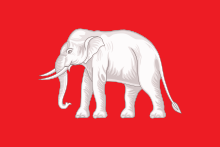Siam Nakhon Province
| Siam Nakhon / Siemmarat | |||||
| Province of Thailand | |||||
| |||||
|
Flag | |||||
| Capital | Siem Reap | ||||
| History | |||||
| • | Established | 1867 | |||
| • | Ceded to France | 1907 | |||
| Today part of | | ||||
Siam Nakhon (Thai: สยามนคร) is the name of a former Thai province. It was a changwat (province) of Thailand, but was ceded to French Indochina in 1907. The name of Siam Nakhon was later changed to Siem Reap in Cambodian.
The capital city of the Khmer Empire in ancient times was declining in the 17th century. In the mid-fourteenth century, the Siamese or Thai speaking people, from Chao Phraya River plain, rose to power. The new Siamese kingdom of Ayutthaya was founded and started expanding eastwards, towards Angkor.
After years of internal strife in Angkor, Angkor was slowly in decline and there was in-fighting between the Khmers for the Angkorian throne. Eventually Angkor Thom was sacked and abandoned until the nineteenth century.
Following the Franco-Thai Treaty of 1867, Siem Reap and Battambang provinces were ceded to Thailand in return for Thailand renouncing suzerainty over the rest of Cambodia. Siem Reap city was under total Siamese control. The Siamese then called this province Siam Nakhon, (later known as Siemmarat), meaning "Siamese town."
At the beginning of the 20th century the province (along with Battambang) was in turn ceded back to Cambodia (now part of French Indochina) in the Franco-Thai Treaty of 1906, due to the higher military power of the colonial French. The French position being the former relationships of the court of Angkor to the Vietnamese (also a part of French Indochina), the history of Angkor as the capital of the Khmer empire and the French desire for the complete territorial integrity of French Indochina.
The province was renamed Siem Reap, which in Khmer means "Defeat of Siam", referring to the fact that the Siamese were no longer in control of the ancient Khmer capital of Angkor Thom and its temples, particularly Angkor Wat.
